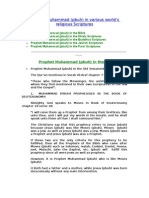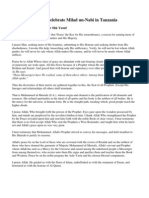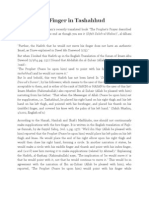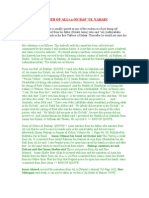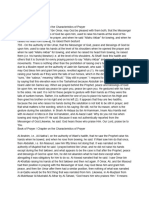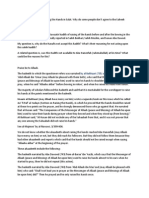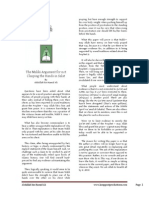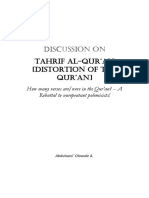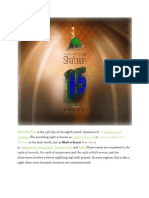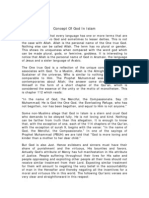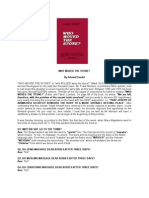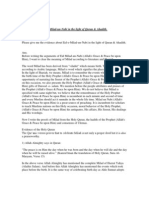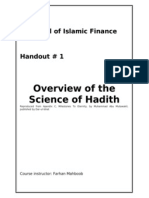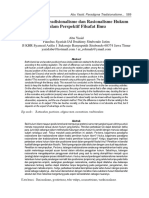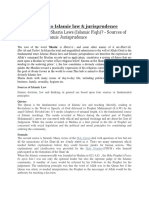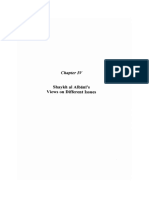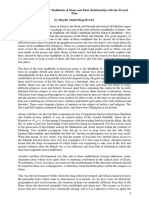Moving The Finger in Swalaat
Moving The Finger in Swalaat
Uploaded by
mrpaharyCopyright:
Available Formats
Moving The Finger in Swalaat
Moving The Finger in Swalaat
Uploaded by
mrpaharyOriginal Title
Copyright
Available Formats
Share this document
Did you find this document useful?
Is this content inappropriate?
Copyright:
Available Formats
Moving The Finger in Swalaat
Moving The Finger in Swalaat
Uploaded by
mrpaharyCopyright:
Available Formats
Important Issues of Fiqh [Jurisprudence] Moving the Finger in Tashahhud
With reference to al-Albani's recently translated book "The Prophet's Prayer described from the beginning to the end as though you see it (Sifah Salah-alNabee)", al-Albani claimed (pg. 66): "Further, the Hadith that he would not move his finger does not have an authentic Isnad, as I have explained in Daeef Abi Daawood (175)." But when I looked this Hadith up in the English Translation of the Sunan of Imam Abu Dawood (1/984, pg. 252) I found that Abdallah ibn al-Zubair (Allah be pleased with him ) said : "The Prophet (Peace be upon him) used to point with his finger (at the end of tashahhud) and he would not move it." But lo and behold, this very Hadith has not been listed In "Daeef Ahadith of Abu Dawud's Sunan", by his followers; which means to the user of this list that this Hadith is acceptable to them, and is either of the rank of SAHIH or HASAN to the user of this list! Imam Muslim (Rahimahullah) also reported Ibn al-Zubair (Allah be pleased with him) narrating from his father: "That when the Messenger of Allah (Peace be upon him) sat for supplication, i.e. Tashahhud, he placed his right hand on his right thigh and his left hand on his left thigh, and pointed with his forefinger, and placed his thumb on his (middle) finger, and covered his knee with the palm of his left hand." (Sahih Muslim, 1/1202, English ed'n) According to the Hanafi, Hanbali and Shafi'i Madhhabs, one should not continuously make supplications with the fore-finger. It is written in the English translation of Fiqh-us-Sunnah, by As-Sayyid Sabiq, (vol. 1, pg. 157): "Wa'il ibn Hajr (Allah be pleased with him) reported that the Prophet (Peace be upon him) would place his left palm on his left thigh and knee. He would place the end of his right elbow upon his right thigh and would then close his right hand, forming a circle. In another narration it states, he would make a circle with his middle finger and thumb and point with his index finger, and (wa'il) saw him moving it to make supplications (related by Ahmad)." Explaining the Hadith, al-Bayhaqi (Rahimahullah) says, "The implication of 'he would move it' is that he would point with it, not that he would continue to move it." This would be in agreement with the narration of Ibn az-Zubair
(Allah be pleased with him), who reported, "The Prophet (Peace be upon him) would point with his finger while supplicating, and he would not move it." This is related by Abu Dawud with a Sahih chain. An-Nawawi also mentioned it. (NB - Both Imams al-Bayhaqi and Nawawi were great Shafi'i scholars of Hadith who followed this Hadith of Ibn al-Zubair, besides so many other scholars of Hadith). Now, there is also a footnote (no 11) by the translator Jamal Zarabozo who said, "In his notes to Mishkat al-Masabih, al-Albani has discussed the Hadith of Wa'il ibn Hajr and of Ibn az-Zubair. He said that the first Hadith has a Sahih chain. The narrators of the latter Hadith (i.e of Ibn al-Zubair) are all trustworthy. Muhammad ibn Ijlan (a narrator in the chain going back to Ibn az-Zubair) has some weakness due to his memory, but his memory was not so poor as to drop to the rank of hasan (a good Hadith). Therefore, the statement recorded by Sabiq that the chain is Sahih is incorrect (i.e only if you accept alAlbani's classification of Hadith); The important words in the latter Hadith are, 'and he would not move it.' According to al-Albani this addition is irregular and rejected (shadh and munkar)." And I Say: "al-Albani's followers have not said that it is shadh and munkar in their Daeef Ahadith of Abu Dawud's Sunan !" Again referring to Fiqh-us-Sunnah (vol. 1, pg. 158), Sabiq says: "According to the Shafiyyah, one points with the finger only once, when saying 'except Allah' in the statement bearing witness. The Hanafiyyah raise the finger in the denial part of the Statement (there is no God) and put it back down during the confirmation part (except Allah). The Malikiyyah (see below for the Maliki view) move the finger to the left and to the right until they finish the prayer. The Hanbaliyyah point with the finger every time they mention Allah, as a reflection to the oneness of Allah, and they do not move it." Another two Hadith on this issue have been related by Imam Muslim (Rahimahullah) in his Sahih: "Ibn Umar (Allah be pleased with him) reported that when the Messenger of Allah (Peace be upon him) sat for the tashahhud he placed his left hand on his left knee, and his right hand on his right knee, and he raised his right finger, which is next to the thumb, making supplication in this way, and he stretched his left hand on his left knee. Another version on
the authority of Ibn Umar (Allah be pleased with him) says: When the Messenger of Allah (Peace be upon him) sat for the tashahhud, he placed his left hand on his left knee and placed his right hand on his right knee, and he formed a ring like (Arabic number 53) and pointed with his finger of attestation. (Also) Ali ibn Abd al-Rahman al-Mu'awi reported: Abdullah ibn Umar (Allah be pleased with him) saw me playing with pebbles during prayer. After finishing the prayer he forbade me (to do it) and said: Do as the Messenger of Allah (Peace be upon him) used to do. I said: How did Allah's Messenger (Peace be upon him) do? He said that he (the Messenger of Allah) sat at tashahhud, placed his right palm on the right thigh and closed all his fingers and pointed with the help of the finger next to the thumb, and placed his palm on his right thigh." (Sahih Muslim, 1/1203-4, English ed'n) Imam Ibn Abi Zaid al-Qairawani (d. 389 AH; Rahimahullah) who is famed with the title 'little Malik', gave the view of the Maliki Madhhab in his alRisala (pg. 31) in the following words: "At the time a worshipper reads the tashahhud, that is the tahiyyah, he places his hands on his thighs. He then folds the fingers of his right hand, but he leaves his index finger unfolded and pointing forward with its side pointing towards his face. There are differences of opinion about the interpretation of the state of the finger. Some believe that, keeping the finger still signifies that Allah is one God. Those who shake it consider it a club with which to ward off the Satan. I consider that the interpretation of that is that it reminds the worshipper that he is in the state of prayer, and that moving the finger shall prevent him from forgetting himself. The worshipper then places his left hand on his left thigh with the palm downwards, he must not move it nor point with it." Finally, it is written in the English translation of Umdat al-Salik wa Uddat alNasik - {This book gives the Shafi'i Madhhab's views} (The Reliance of the Traveller, by Shaykh Ahmad Ibn Naqib al-Misri, d. 769AH/1368 CE; Rahimahullah, trans. Nuh Ha Mim Keller, pg. 142, f8.44): "One does not move it while it is thus raised (Shaykh Umar Barakat said in his commentary to Umdat al-Salik: following the Sunnah from a Hadith related by Abu Dawud. It is offensive to move it here, though some hold that it is recommended, the evidence for which is also from the Sunnah, in a Hadith related by Bayhaqi, who states both Hadiths are rigorously authenticated (Sahih). Precedence is given to the former Hadith (i.e of Ibn Az-Zubair), which negates moving the finger, over the latter Hadith, which affirms it, because scholars hold that what is sought in prayer is lack of motion, and moving it diminishes one's
humility). (I say: al-Albani's comment on the Hadith of Ibn al-Zubair: 'Even if it were authentic, it is negatory, while the Hadith above is affirmatory: the affirmatory takes precedence over the negatory, as is well known among the scholars' [see pg. 66 of Sifah Salah an-Nabee] is of no consequence to what most of the Fuqaha (Jurisprudents) have said from amongst the Hanafi, Shafi'i and Hanbali scholars, but his opinion is only supported by the Malikiyyah, so do not be confused). The Prophet's moving it was merely to teach people that it was permissible (and Shaykh Abdal-Wakil Durubi said: 'As it was the Prophet's (Peace be upon him) duty to distinguish for his Community the acts that were offensive from those that were unlawful, and he was given the reward of the obligatory for doing such offensive acts'). Moreover, Bayhaqi says that the meaning of 'moving it' in the latter Hadith is simply raising it, so there is no actual contradiction)." From the above discussion we may briefly say in summary that al-Albani labelled the Hadith of Abdallah ibn al-Zubair as being DAEEF according to what he said in 'Sifah-Salah an-Nabee, (pg. 66), but his followers have not labelled it as being DAEEF in 'Daeef Ahadith of Abu Dawud's Sunan'!! Also according to Jamal Zarabozo's quotation from al-Albani's checking of Mishkat ul-Masabih, this same Hadith was of the rank of HASAN, and not DAEEF as he had said in 'Daeef Abi Dawood (no 175)'; is this not a grave contradiction? We should rather accept the checking of such great memorizers of Hadith like the Imam's Bayhaqi and Nawawi (Allah's mercy be upon them). Allah knows best.
The Placing of Hands in Prayer With regard to the placing of the hands below the navel in Salah (see Sifah Salah an-Nabee, appendix 4, pg. 102-103, English ed'n), al-Albani has declared all the Hadith that reached him on this issue to be Daeef, due to the presence of the narrator Abdar-Rahman ibn Ishaq al-Wasiti al-Koofi. This may be true due to what the scholars of Hadith have said, but he has either overlooked the fact that there are many other Ahadith which order the placing of the hands below the navel, or has deliberately not bothered to mention them to his readers who are usually unaware of this fact! Al-Albani claims on page 12 of the same book : "To place them on the chest is what is proved in the
Sunnah, and all that is contrary to it is either Daeef or totally baseless." But he contradicts himself on page 102-103 of the same book by saying: "What further points to its weakness (i.e. the Hadith of Abdar-Rahman ibn Ishaq) is that contrary to it has been narrated on the authority of Ali (Allah be pleased with him) with a better Isnad: the Hadith of Ibn Jareer al-Dabbi an (from) his father, who said, 'I saw Ali holding his left arm with his right on the wrist, above the navel (I say: The statement above the navel, does not mean on the chest, but literally above the navel and below the chest, since this is the opinion of the Shafiyyah scholars like Bayhaqi, Nawawi, Muslim and so on) this Isnad is a candidate for the rank of HASAN; Baihaqi (1/301) firmly designated it to be Hasan, and Bukhari (1/301) designated it with certainty while giving it an abridged, ta'leeq form." Is this not a clear contradiction from within the same book? And this is not all my dear reader... Al-Albani claimed that it was found in Bukhari (1/301), but when I examined the Sahih al-Bukhari (Vol. 1, Chapter. 6, no. 707, pg. 396, English ed'n), I did not find this narration of Ibn Jarir al-Dabbi (Allah be pleased with him), but instead a Hadith from Sahl ibn Sa'ad (Allah be pleased with him) who said: "The people were ordered to place the right hand on the left forearm in the prayer." Abu Hazim said, " I knew that the order was from the Prophet (Peace be upon him)." [see also Muwatta of Imam Malik, section 9.15, no 50, pg 70, English trans'n by A. Abdarahman and Y. Johnson for a very similar narration]. According to the author of Ja'al Haqq, Shaykh Ahmad Khan, there is not even one Hadith in the Sahih collections of al-Bukhari and Muslim which specify where the hands should be placed! Now you have just read above that al-Albani classified the Hadith of Ibn Jarir al-Dabbi to be HASAN, but when I found this very Hadith in the Sunan of Abu Dawood (1/756, pg. 194, English ed'n) and cross referenced it to the list, "Daeef Ahadith of Abu Dawud's Sunan." I found that his followers listed it as being DAEEF!! Imam Abu Dawood (Rahimahullah) said after relating the Hadith from Ibn Jarir al-Dabbi: "Sa'id ibn Jubair narrated the words: 'above the navel'. Abu Mijlaz reported the words: 'below the navel'. This has also been narrated by Abu Hurayra (Allah be pleased with him). But that is not strong." The latter quote is one which al-Albani failed to mention in "Sifah Salah anNabee!"
Note also that al-Albani said with regard to the placing of the hands on the chest (see Sifah Salah an-Nabee, pg. 12, in the footnote): "In fact, Imam Ishaq ibn Rahwaih acted on this Sunnah, as Marwazi said in 'Masaa'il (pg 222): 'Ishaq used to pray witr with us.... he would raise his hands in qunoot, and make the qunoot before bowing, and place his hands on his breast or just under his breast.'" But when Iread the footnote to Abu Dawood's Sunan (vol. 1, pg. 194, fn. 345, English ed'n), I noticed that the author of Awn al- Mabood (1,275), Shams alHaqq Azimabadi, claimed that both Abu Ishaq al-Marwazi and al-Hafiz Ishaq ibn Rahwaih (one of Imam al-Bukhari's teachers) held the position that the hands should be folded below the navel! In his Sahih Muslim sharifMukhtasar Sharh Nawawi (vol. 2, pg. 28, fn. 23), Wahid az-Zaman (a late scholar of the 'Salafiyya' in Pakistan) also affirmed that the Imam's Sufyan alThawri, Abu Hanifah, Ishaq ibn Rahwaih and Abu Ishaq al-Marwazi (Allah's mercy be upon them) all used to place their hands below the navel! So who do you think is quoting correctly, al-Albani or al-Azimabadi and az-Zaman? Here is the full quote from Abu Dawood's Sunan: "The question of folding hands in prayer below the navel is disputed amongst the jurists. According to Abu Hanifah, Sufyan al-Thawri, Ishaq ibn Rahwaih, Abu Ishaq al-Marwazi (I say: others who held the same view include the Mujtahid's like Ibrahim al-Nakhai, Hammad ibn Abi Sulayman, Abu Yusuf, Muhammad al-Shaybani, Zufar ibn Hudayl and many other scholars, Allah's mercy be upon them), the hands should be folded below the navel. This tradition is followed by them (I say: it is not just this tradition which lends support to placing the hands below the navel, but others as well). According to al-Shafi'i, the hands should be placed below the chest (I say: this is also the opinion of Imam Muslim, according to the chapter heading used by him: 'The placing of the right hand over the left hand after the first takbir in prayer below the chest and above the navel and then placing them opposite the shoulders in prostration' -see Sahih Muslim, vol. 1, pg. 220, English ed'n). AlNawawi says that this is the view of the majority of the jurists (this may have been in Imam Nawawi's day, but it is well known that through out the centuries of Islam in aggregate, most of the Ulama as well as the common folk have been placing their hands below the navel, by Allah's decree and will). Two statements have been attributed to Ahmad ibn Hanbal (see al-Albani's Sifah Salah an-Nabee, footnote on pg. 51). According to the third view
ascribed to him he does not give any preference to any of these two views. One has the choice of placing the hands. Malik is also reported to have held two different views. According to the second, he held that one should leave the hands in their natural position without folding them. One should not fold them placing one on the other." NB- The most authoritative position of Imam Malik (Rahimahullah) has been recorded in al-Mudawwana al-Kubra, by Qadi Sahnoon (d. 240 AH). This book contains the most authentic positions of al-Imam Malik and his illustrious disciples, namely Imam ibn al-Qasim and Imam ibn Wahb. Qadi Sahnoon recorded the declarations of Imam Malik directly from Imam ibn alQasim, hence there is no real doubt in my mind that whatever has been recorded in this book is the Madhhab of al-Imam Malik, and usually the amal (practise) of the people of Madinah in his day. In al-Mudawwana (vol. 1, pg. 75-76), Imam Malik has been recorded to have said, "Putting the right hand on the left in salah, I have no knowledge of it in the compulsory (fard) prayer, it is thus disliked (makrooh). But in the supererogatory (nafl) prayer there is no harm (in folding the hands), it is left to the individual to decide." This statement from Imam Malik is a strong proof against those who claim that Imam Malik only prayed with his hands at his sides, after he received a severe beating (see The Evolution of Fiqh, pg. 70, by A.A. Bilal Philips)! Al-Albani has only 'checked' six Hadith which allow the placing of the hands below the navel (see his 'Sifah', pg. 102, Appx. 4). But there are more than 6 other Hadith (which allow the placing of the hands below the navel) which he has not bothered to mention/check; may be he has not come across them! One of such Hadith is very similar to what al-Albani mentioned in "Sifah Salah anNabee," pg. 11: "We, the company of Prophets, have been commanded to hasten the breaking of the fast, to delay the meal before the fast, and to place our right arms on our left arms during prayer [from Ibn Hibban and Diyaa', with a Sahih Isnad according to al-Albani]. The version I have is related by Sayyidina Ali (Allah be pleased with him): "Three things are from the habits of Prophethood: To hasten the breaking of the fast, to delay the Sehri (pre-fast meal) as late as possible, and to place one's right hand on top of the left hand below the navel (transmitted by Hafiz Ibn Shaheen)." To finish, As-Sayyid Sabiq quoted Imam Tirmidhi (Rahimahullah) as saying in Fiqh-us-Sunnah (vol. 1, pg 132): "Knowledgeable Companions (Allah be pleased with them all), their followers and those that came after them believed
that one should put his right hand over the left during prayer, while some say above the navel and others say below the navel."
Raful-Yadain : The Raising of Hands in Prayer Another point I wish to raise concerns the long disputed issue of raising the hands in prayer (salah). It is a well known fact that al-Albani and the generality of people amongst the 'Salafiyya' have made a mountain out of a molehill, and have brewed a storm in a tea cup with regards to this issue, such that many of them are bold enough to accuse those who do not raise their hands in Salah (i.e. after the initial raising called Takbir-Tahrimah) of not following the Sunnah, as well as going to the disgusting length of openly detesting and despising those who do not raise their hands after the first Takbir! I must also admit that among those who do not raise their hands in the subsequent stages of Salah, usually the ignorant people have accused those who raise the hands in the other stages of Salah to be 'Wahabbi's!' This is due to ignorance and pride of both sides, which usually stems from the lack of knowledge of the opinion of our great Mujtahid Imam's, and the Ahadith based evidences used by the research scholars in their respective defence of either raising or not raising the hands in the other stages of Salah. Our brothers and sisters who accuse those of raising the hands in the other stages of prayer should ask themselves: "Were the great Imam's like al-Shafi'i and Ahmad ibn Hanbal (Allah's mercy be upon them) Wahhabi's?" I pose this question because it is well known that both of the latter named Imam's used to practise Raful-Yadayn after the initial Takbir, besides many other Companions and successors (Tabi'een), may Allah be pleased with them all! It is a well known fact from the Mutawateer Ahadith (a report of a large number of narrators whose agreement upon a lie is inconceivable) available to us, that the Holy Prophet (Peace and blessings be upon him) used to raise his hands when pronouncing the initial Takbir in Salah. Sayyid Sabiq stated in his Fiqh-us-Sunnah (vol. 1, pg 129): "Says Ibn al-Mundhir, 'All scholars agree that the Prophet (Peace be upon him) raised his hands at the beginning of his prayer.' Commenting upon this report, Ibn Hajar (al-Asqalani) says, 'The Prophet's raising his hands at the beginning of his prayer has been narrated by
fifty companions, including the ten who were given the tidings of Paradise.' Al-Bayhaqi related that al-Hakim said, 'I do not know of any Sunnah other than this one which is accepted by the four rightly guided Khalifahs, the ten companions who were given the tidings of Paradise, and other Companions scattered across many lands." (NB-In my own experience, the only people I have met who do not raise their hands in any stage of the Salah have been the remnants of a Kharijite sect called the Ibaadiyah, nor do they fold their hands in Salah). Now, the difference in opinion stems on the question of whether the raising of the hands is necessary in the other stages of Salah, like when going into Rukoo, standing up from Rukoo, in between the prostrations (sajdah) and when standing up for the third rakah in Salah... Al-Albani said in "Sifah Salah an-Nabee, pg. 42, fn. 4": "The raising of the hands is reported as Mutawateer from him (Peace be upon him), as is the raising of the hands on straightening up after Rukoo. It is the Madhhab of the three Imams Malik, Shafi'i and Ahmad, and of the majority of scholars of Hadith and Fiqh. Imam Malik practised it right up to his death, as reported by Ibn Asakir (15/78/2). Some of the Hanafi's chose to do it, among them Isam ibn Yusuf Abu Asamah al-Balkhi (died. 210 A.H.), a student of Imam Abu Yusuf, as has been explained in the introduction." I wish to say to the bias of al-Albani, "You have quoted a portion of the truth correctly, but have also blundered in one of your opinions!" It is absolutely true that the great Mujtahid Imams like al-Shafi'i and Ahmad ibn Hanbal (Allah's mercy be upon them) recommended the raising of the hands in the other subsequent stages of Salah, but it is a mistake to say that the great Imam of Madinah, Malik ibn Anas (Rahimahullah) "practised it right up to his death" as al-Albani claims, by quoting from Imam Ibn Asakir (a Shafi'i scholar of Hadith, and a staunch defender of Imam Abu'l Hasan al-Ashari, he wrote a work entitled 'The Exposure by al-Imam Abu'l Hasan al-Ashari of Mischievous untruths, d. 571 AH; Rahimahullah). For the real and authoritative view of Imam Malik and his followers, one must study the books written by the Maliki Madhhab, and then quote their opinions! I say this due to the sensible advice given to me by one of my friends in a written communication. He said:
"One lesson you should learn from all this is not to, for example, take Hadith from someone who is mainly specialized in Fiqh or some other subject, or take Hanafi dalils (evidences used to give legal verdicts) from someone who is not a specialist in the Hanafi madhhab's methodological bases and evidences, or take a Hanbali scholar's word about some ruling in a different madhhab, or take Hadith knowledge from scholars who make large numbers of mistakes, and so on. In general, one does not take an accounting problem to a shoe salesman." For the most authentic view and stance of Imam Malik (Rahimahullah) and his disciples please refer to the appropriate title and discussion later, but as for what al-Albani quoted from Imam Ibn Asakir (Rahimahullah), then I say the authenticity of this report needs to be checked, since al-Albani has failed to classify it himself in his "Sifah Salah an-Nabee," (does this not mean that he wants his readers to 'blindly' accept his verdicts?), and even if Hafiz Ibn Asakir's reference proves to be Sahih, then there is no doubt in my mind that this statement coming from Imam Malik must be rejected in favour of the real position of Imam Malik himself. The statements that I shall be quoting in favour of Imam Malik's authoritative opinion, comes directly from his most famous disciples, where as the reference coming from Ibn Asakir as given by al-Albani, was recorded well over 300 years after the death of Imam Malik (NB- Imam Malik passed away in the year 179 AH; while Imam Ibn Asakir was born in the year 499 AH)! As you have read above al-Albani stated that the Imam's Shafi'i and Ibn Hanbal (Allah's mercy be upon them) performed Raful-Yadayn, but one should also know that on the other hand, the great Mujtahid's amongst our Pious-Predecessors, like Abu Hanifah, Hammad ibn Abi Sulayman, Ibrahim al-Nakhai, Alqama, Aswad (two famous disciples of the great Companion Abdallah ibn Masood), Abu Yusuf, Muhammad al-Shaybani, Sufyan al-Thawri and many other Ulama (Allah's mercy be upon them all) did not perform Raful-Yadayn, except in the initial Takbir, based on many sound chains of narration! So you may now ask: "Why the difference of opinion?" The answer to this small problem is simple; it is only due to preference given to the derived Ijtihad of the available Ahadith on this subject, by individual Mujtahid's of the highest scholarly rank, and not that of the laity amongst the general masses of this Ummah. Since many a scholar has said that it is impermissible to derive legal verdicts from the Qur'an and Sunnah, if one is not qualified to do Ijtihad (see the section on Taqleed), but conversely, what
do we see today (see later)? The Imams who held the view that Raful-Yadayn is unnecessary, besides the initial Takbir, have based their views from many authentic Ahadith coming from the Holy Prophet (Peace and blessings be upon him), as well as directly from the great Companions (May Allah be pleased with them all). The fact of the matter is, that in their view the practise of performing RafulYadayn in the other stages of prayer have been abrogated, and hence unnecessary in performance. Contrary to this, Imam's like al-Shafi'i, Ibn Hanbal.... believe it to be desirable to perform Raful-Yadayn, and in their view the practise has not been abrogated. Consequently, many of the well known and wise research scholars have said that one's Salah is correct and acceptable by the practise of either mode! So please do not fall into the abyss of ignorance, by accusing and abusing each other of performing Salah incorrectly, since it was not generally the way of our foremost Mujtahid's of the pious generations (see the discussion between Imam al-Azam Abu Hanifah and Imam al-Awzai later)! Al-Albani has said that some of the Hanafi's like Shaykh Isam ibn Yusuf alBalkhi (Rahimahullah) chose to perform Raful-Yadayn because he did not know the evidence of his Imams who held the view that Raful-Yadayn was unnecessary after the initial Takbir (See "Sifah Salah an-Nabee, pg xvii," and also "The Evolution of Fiqh, pg. 126", by A.A. Bilal Philips). I find it strange that Shaykh Isam ibn Yusuf did not know the evidence for not performing Raful-Yadayn, since by simple logic one can deduce the fact that he must have seen his two main Imams (Muhammad al-Shaybani and Abu Yusuf) not performing Raful- Yadayn, and hence he must have been curious enough to ask his Imams for the evidence they used for not performing Raful-Yadayn! What seems more apt in a situation like this, is to say that probably Shaykh Isam ibn Yusuf felt that the evidence for performing Raful-Yadayn was more convincing to him, than the converse evidence for not performing RafulYadayn, and Allah knows best. One lesson which can be learnt from this incident, is that if Shaykh Isam ibn Yusuf was a Mujtahid within the Hanafi school, then like all other Mujtahid scholars it is incumbent on him to follow his own Ijtihad, even if it has at times contradicted the founder of the Madhhab he belonged to. Thus, Shaykh Isam had to follow his own Ijtihad. The proof for what I have just said has been agreed upon by most of the scholars who were specialized in the
fundamentals (Usool) of Islam. For example, it is written in the book "Principles of Islamic Jurisprudence", by Mohammad Hashim Kamali (pg. 370): "The Ulema of Usul are in agreement that the Mujtahid is bound by the result of his own Ijtihad. Once he has deduced the ruling on a particular issue which is founded in his true conviction and belief, he may not imitate (Taqleed) other Mujtahids on that matter regardless as to whether they agree with him or otherwise. For the Mujtahid, the conclusion that he reaches is tantamount to a divine command which he must observe. It is therefore unlawful for him to abandon it or to follow anyone else in respect of it. But if he had not rendered his own Ijtihad on an issue which is not urgent, and he has time to investigate, then according to some ulema he may imitate other Mujtahid's. However, the preferred view is that he must avoid taqleed, even of one who might be more learned than him. Only the ammi (layman/nonMujtahid's) who is incapable of Ijtihad is allowed to follow the opinion of others." (The above author has quoted from Imam Ghazzali's Mustasfa, vol.2 pg. 121; Imam Amidi's Ihkam, vol.4 pg. 204 and from al-Kassab's Adwa, pg. 119). The above quote clears some of the misconceptions held by some people on the role of Mujtahid's in Islam. For example, some people who try to refute the Taqleed of the Mujtahid's, bring forward examples in which the disciples of the four main Imams contradicted the Ijtihad of their Master's on certain points. These people should always remember that if a disciple contradicts the opinion of his master, then this is the result of the natural prerogative bestowed upon him, when he attained the high and honourable grade of Ijtihad. There is a well known story related from the great Imam Abu Hanifah (d. 150 AH; Rahimahullah), who said: "I follow the book of Allah, and if I find no solution there, I follow the Sunnah of The Prophet (peace be upon him). If I find no solution in either the Qur'an or the Sunnah, I follow whichever of the pronouncements of the Sahabah I prefer, and leave whichever I wish. If there is a pronouncement on a particular matter by any of the Sahabah, I would not adopt any other made by any other scholar. But, if I found a solution only in the opinions of Ibrahim (al-Nakhai), al-Shabi, Ibn Sirin, Hasan al-Basri, Ata (ibn Abi Rabah) or Sa'eed ibn al-Musayyib (they were all Mujtahid's), I would make Ijtihad just as they did." (vide: "Usul al-Fiqh al-Islami," pg. 64, by Taha Jabir al-Alwani, who reported this account from Tarikh Baghdad, vol. xxxi, pg. 368, al-Intiqa of Ibn Abdal Barr, pg. 142, and Mashayikh Balkh al-Hanafiyah, pg. 190).
This report exemplifies the prerogative of a Mujtahid, as well as why Shaykh Isam ibn Yusuf may have held different opinions from his Masters. I must stress, the above discussion only refers to those who can perform Ijtihad, and not to those who are unable to fulfil the conditions recognized by the scholars of Usool for carrying out the duties of a Mujtahid. Those who are not Mujtahid's are bound to the opinions of qualified Mujtahid's, and this is Taqleed. Al-Albani said in 'Sifah Salah an-Nabee', (pg. 105-6): "About raising the hands on going into Ruku and rising from it, many Ahadith have been narrated from the Prophet (Peace be upon him): they are actually mutawateer in the eyes of the scholars; in fact, raising the hands with every takbir is proven on his authority in many Ahadith; whereas not raising the hands is not authentically related from him except once via Abdallah ibn Masood (Allah be pleased with him), but this is not suitable for putting into practise, for it is naaf (negatory). It is firmly established, in the eyes of the Hanafi's and others, that the muthbit (affirmatory) takes precedence over the naaf (negatory); this is even when the affirmatory is on its own, let alone the case when it is a multitude of narrations, as in this issue! On the basis of this principle, and in the absence of anything contrary, this renders it binding on them to adopt the raising of the hands, and not to stick zealously to the Madhhab after the establishment of proof. However, it is a pity that only a handful of the earlier or later ones have adopted it, so much so that not raising the hands has become a land mark for them!" The above quote shows the limited and superficial knowledge of al-Albani, in the evidences used by the Hanafi scholars for not performing Raful-Yadayn! It is true that the Ahadith confirming Raful-Yadayn are Mutawateer, but what the reader should also know, is that not performing it has also come down to us in a Mutawateer way! In fact there are more than 50 Ahadith proving the converse of what the "great scholar," al-Albani holds, as well as those who bolster his claims! Al-Albani claims that not raising the hands has come to us authentically only, "once through Abdallah ibn Masood, but this is not suitable for putting into practise." To which I reply, why should it not be possible to put into practise the Hadith related by the great Companion Ibn Masood (Allah be pleased with him)? Did he (Allah forbid) lie or fabricate from the Prophet (Peace be upon him)?
Please do not forget that there are many other authentic Ahadith to back up the opinion of the Hanafi's (and Maliki's)! Al-Albani only explains this Hadith of Ibn Masood away by bringing in the jurisprudential principle of, "the affirmative takes precedence over the negatory", but his argument is fallacious in this case, since I have already said that the Hanafi's believe that the performance of Raful-Yadayn has been abrogated by many other Ahadith, hence the above principle is inapplicable in this case! He claims the Hadith from Ibn Masood (Allah be pleased with him) has been only related authentically once. I say this is incorrect, and only due to his ignorance of all the available routes (Asanid) coming from Ibn Masood. As far as I know he has not listed the Hadith of Ibn Masood to be Daeef, in his checking of Imam Abu Dawood's Sunan, since his followers have not recorded it in their, "Daeef Ahadith of Abu Dawud's Sunan". The Hadith in question is from Alqamah (Rahimahullah), who said: "Abdallah ibn Masood (Allah be pleased with him) said :'Should I pray in the way the Apostle of Allah (Peace be upon him) had performed it?' He said: 'He prayed, raising his hands only once.'" [Abu Dawood, 1/747, pg. 193, English ed'n]. Since it has not been listed in the above mentioned publication, this means that the above narration is either Sahih, or at least Hasan to the user of the list. Note also, according to Shams al-Haqq Azimabadi, in his book Awn alMabood (1,272-73), the above Hadith was regarded to be Hasan by Hafiz Ibn Ma'een (Rahimahullah), and it is well known that Imam Tirmidhi (Rahimahullah) rated it to be Hasan (see Sunan al-Tirmidhi, 2/257, pg. 40-41, edited by Ahmad Muhammad Shakir). The above Hadith has been related from Imam al-Azam Abu Hanifah (Rahimahullah), through an absolutely SAHIH chain (all the narrators given below were well known Mujtahid's and absolutely truthful), and here it is: Imam Abu Hanifah (Rahimahullah) has related to us from his teacher, Imam Hammad ibn Abi Sulayman (Rahimahullah), who related from his teacher, Imam Ibrahim al-Nakhai (Rahimahullah), who related from his two teachers Imam Alqamah and Imam Aswad (Allah's mercy be upon them), the two distinguished pupils of Ibn Masood (Allah be pleased with him), who related from Ibn Masood (Allah be pleased with him), who related from the Holy Prophet (Peace and blessings be upon him). The reference for this is given after the discussion between Imam Abu Hanifah and Imam al-Awzai (Allah's
mercy be upon them), please see below. So my dear reader, I have just proven to you that the Hadith from Ibn Masood has come to us authentically, through at least two authentic routes, as given above. Can you now believe in alAlbani's assertion that it has only come through one authentic narration? As for al-Albani saying, "However, it is a pity that only a handful of the earlier or later ones (i.e. Hanafi's) have adopted it, so much so that not raising the hands has become a landmark for them!" I say this statement is due to his ignorance, lack of scholarly deduction and knowledge of the principles and proofs held by the Hanafi's! He claims that it has become a "landmark", for the Hanafi's only! I say, "O 'Shaykh', have you not contradicted yourself by admitting that others besides the Hanafi's do not raise their hands in Salah in the same book?" Here is al-Albani's admission that it is not just the Hanafi's who have made it a "landmark"; he said in "Sifah Salah an-Nabee," (footnote to pg 91): "The Ibaadiyyah have distorted this hadeeth: their scholar Rabee' has related it in his unreliable Musnad with a different wording to justify their view that raising the hands with takbeer invalidates the Prayer! That wording is false, as I have explained in ad-Da'eefah (6044)."!!! This by Allah, is a grave contradiction from within the same book, and tantamount to his admission that besides the Hanafi's, the Ibaadiyyah sect do not also raise their hands! In fact we have on record some scholars who initially used to perform RafulYadayn, but later on in their lives they stopped performing it altogether, except for the initial Takbeer; when they had taken into account all the arguments and evidence. Two of such great scholars are as follows:(A) Imam Abu Ja'far al-Tahawi (d. 321 AH; Rahimahullah): He was a Mujtahid in specific issues (Mujtahid fi al-Masa'il) and also the famous author of the work 'Al-Aqeeda al-Tahawiyya' (The Muslim Belief According to al-Tahawi), which has been translated into English by two different organisations, and many other works on Hadith. He was originally a Shafi'i scholar who gained mastery in Shafi'i Fiqh from his famous uncle Imam al-Muzani (Rahimahullah) [mentioned in Sifah Salah an-Nabee, pg. xvi], who was the famous disciple of Imam al-Shafi'i (Rahimahullah). But later in his life he joined the Hanafi school and hence stopped performing RafulYadayn indifference to the Shafi'i view of performing it. Imam Tahawi lived in a time when most of the Hadith had been collected (after Bukhari, Muslim etc), hence he had an ideal opportunity to sift through the Hadith on RafulYadayn and he came to the conclusion that Imam Abu Hanifah's
(Rahimahullah) view point was more convincing to him, and in this regard he quoted some Hadiths negating the practise of Raful-Yadayn in some of his works. (B) Imam Muhammad Amin ibn Abidin (d.1252/1836; Rahimahullah): He was also originally a Shafi'i scholar who changed his school and became the foremost Hanafi Imam of his time. Hence he also changed his original opinion of performing Raful-yadayn, to not performing it. His most famous work is 'Hashiya Radd al-Mukhtar'. Al-Albani has quoted from him in 'Sifah Salah an-Nabee' (pg's viii, xvii).
The View of Imam Malik and his Madhhab on Raf-ul-Yadayn I have already quoted the opinion of al-Albani with regard to his quotation from Imam ibn Asakir. Al-Albani has claimed that Imam Malik used to perform Raful-Yadayn right upto his death. But this is in direct contradiction to what has been related from Imam Malik (Rahimahullah) by his famous disciple, Imam ibn al-Qasim. The foremost book of the Maliki Madhhab in terms of Fiqh is a book called 'Al-Mudawwanah' (A Book of Legal Cases). It is a recension of Qadi Sahnoon (Rahimahullah), containing his questions, answered by Imam Ibn al-Qasim (Rahimahullah). These answers repeat the literal words of Imam Malik (Rahimahullah) by occasional personal interpretation of Ibn al-Qasim himself. It is written in "al-Mudawwanah", (vol. 1, pg. 71): "Imam Malik has said that he does not know of Raful-Yadayn being done in any Takbeer, even when going into (Rukoo) or rising from it, except in the Takbeer Tahrimah (the initial Takbeer), then ibn al-Qasim said that in the opinion of Imam Malik the performance of Raful-Yadayn was Daeef (a weak practice)." The diligent reader may have noticed that Imam Malik has quoted two Hadith which seems to support the practice of performing Raful- Yadayn, in his celebrated al-Muwatta! The Hadith quoted is as follows, "Yahya related to me from Malik from Ibn Shihab from Salim ibn Abdullah from Abdullah ibn Umar (Allah be pleased with them) that the Messenger of Allah, may Allah bless him and grant him peace, used to raise his hands to the level of his shoulders when he began the prayer and when he raised his head from ruku he raised them in the same way, saying, 'Allah hears whoever praises him, our Lord and praise belongs to You.' He did not raise them in sujud (prostration)." Also, "Yahya related to me from Malik from Nafi that Abdullah ibn Umar used
to raise his hands to the level of his shoulders when he began the prayer and when he raised from the ruku he would raise them less than that." (see Muwatta section 3.4, no. 17 and 21, pg. 27, trans. by A. Abdarahman and Y. Johnson). The above Hadith has also been related by Imam's Bukhari and Muslim in their respective collections, besides many other books of Hadith with slight variations in wording and description. The above Hadith has been one of the main proofs used to prove the performance of Raful-Yadayn by some great scholars. But, the Hanafi and Maliki schools put forward some of the following arguments to explain their contention. The Imam Abu Dawood (Rahimahullah) reported a Hadith very similar to the one above, he said that Imam Nafi said on the authority of Ibn Umar (Allah be pleased with him) that when he began his prayer, he uttered the Takbeer (Allah is most great) and raised his hands; and when he bowed (he raised his hands); and when he said: "Allah listens to him who praises Him," (he raised his hands); and when he stood up at the end of two rak'ahs, he raised his hands. He (Ibn Umar) traced that back to the Apostle of Allah (may peace be upon him). Abu Dawood then said: "What is correct is that the tradition reported by Ibn Umar does not go back to the Prophet (may peace be upon him)." Abu Dawood then said: "The narrator Baqiyyah (found in the Isnad) reported the first part of this tradition from Ubaid Allah and traced it back to the Prophet (may peace be upon him); and the narrator al-Thaqafi reported it from Ubaid Allah as a statement of Ibn Umar himself (not from the Prophet). In this version he said: 'When he stood at the end of two rak'ahs he raised them up to his breasts. And this is the correct version." Abu Dawood then said: "This tradition has been transmitted as a statement of Ibn Umar (and not of the Prophet) by al-Layth ibn Sa'ad, Malik,Ayyub, and Ibn Juraij; and this has been narrated as a statement of the Prophet (Peace be upon him) by Hammad ibn Salamah alone on the authority of Ayyub. Ayyub and Malik did not mention his raising of hands when he stood after two prostrations, but alLayth mentioned it in his version. Ibn Juraij said in his version: I asked Nafi, "Did Ibn Umar raise (his hands) higher for the first time?' He said, 'No.' I said, 'Point out to me. He then pointed to the breasts or lower than that.'" (see Sunan Abu Dawood, 1/740, pg. 191, English ed'n). Now, the Hadith related by Ibn Umar (Allah be pleased with him) stated that the Prophet (Peace be upon him) "used to" perform Raful-Yadayn; although
Imam Malik (Rahimahullah) quoted this particular Hadith it does not necessarily mean that he himself, as well as Ibn Umar (Allah be pleased with him) performed Raful-Yadayn! In fact we have to remember that Ibn Umar (Allah be pleased with him) said that the Prophet (Peace be upon him), "used to" perform Raful- Yadayn. I say this because we have many other Ahadith which have been related from Abdullah Ibn Umar (Allah be pleased with him) himself which prove that he did not always perform Raful-Yadayn, as well as indicating that the Holy Prophet (Peace and blessings be upon him) himself stopped performing Raful-Yadayn; but Allah knows best! Here follows a few of these Ahadith from Ibn Umar (Allah be pleased with him):- (A) The Imam of Hadith, Abu Awaanah (Rahimahullah) related in his "Sahih" (vol. 2, pg. 90) from Sufyan ibn Uyayna, who related from Ibn Shihab al-Zuhri, who related from Salim ibn Abdullah, who related from his father Abdullah ibn Umar, who said: "I saw the Prophet (Peace be upon him) raise both his hands up to the shoulders when starting Salah, but he did not raise his hands when going into rukoo, or when rising from it; not even between the prostrations (sujud)." (B) The Imam of Hadith and teacher of Imam al-Bukhari, Abdullah Ibn Zubair al-Humaidi (Rahimahullah) related in his "Musnad" (2/614, pg. 277) from Sufyan ibn Uyayna, who related from Ibn Shihab al- Zuhri, who related from Salim ibn Abdullah, and he from his father Ibn Umar: "I saw the Prophet (Peace be upon him) raise both his hands at the beginning of Salah up to his shoulders, but when going into Rukoo and when raising his head from rukoo he did not raise his hands, not even between the prostrations." (C) The Hanafi scholar of Hadith, Imam Yusuf al-Zaylai (d. 762 AH; Rahimahullah) quoted in his book "Nasb ar-Rayah" (vol. 1, pg. 404), a narration from Abdallah ibn al-Kharraz, who related from Imam Malik, who related from Ibn Shihab al-Zuhri, and he from Salim ibn Abdallah, who related from Ibn Umar, who said: "The Prophet (Peace be upon him) raised his hands when beginning Salah, and he never repeated again." (D) The two well known scholars of Hadith, Imam Tahawi and Imam Ibn Abi Shaybah (Allah's mercy be upon them), related that Imam Mujahid (the disciple of Ibn Abbas; Allah be pleased with them) said: "I prayed many times behind Ibn Umar, but he raised his hands only once at the beginning." (see Ja'al Haqq, pg. 55, by Mufti Ahmad Y. Khan) These four narrations give strong evidence in favour of the Hanafi and Maliki views that Raful-Yadayn has been abrogated. So now ask yourselves, "Can the opinions of al-Albani be relied
upon, if he does not base his opinions from the books of the Hanafi and Maliki Schools, plus the proofs used by them for not performing Raful-Yadayn?" Now, I leave it to you to decipher for yourself, why certain Imams decided to perform Raful-Yadayn and others not to; but before I finish on this issue let me relate to you a famous incident that took place between the Imam's Abu Hanifah and al-Awzai (Allah's mercy be upon them) of Syria, when they met in Makkah. The purpose of the following debate is to show that even though the two great Imams had different narrations to prove their particular opinions, they did not abuse or despise each other in the derogatory way that some of us have become accustomed to! Insha'Allah, we should respect each others opinions, if it has a sound basis from the sources of the Shari'ah. Imam al-Awzai said, "Why do you not raise your hands just before rukoo and after?" Imam Abu Hanifah replied, "There is no recorded word or action of the Messenger of Allah (peace be upon him), to authenticate this (any longer)." "How so", replied al-Awzai, "When al-Zuhri has reported this to me on the authority of Salim and that of his father (ibn Umar) who said that the Prophet (Peace be upon him) used to raise his hands at the beginning of the Salah and before and after rukoo?" Abu Hanifah also reported, "Hammad related to me through Ibrahim, through Alqamah, through al-Aswad, and through ibn Masood, that the Messenger of Allah (Peace be upon him), only raised his hands at the beginning of the Salah and did not repeat this action again." AlAwzai then suggested that his authorities were more reliable than those of Abu Hanifah, who countered, "Hammad was more knowledgeable than al-Zuhri, and Ibrahim was more knowledgeable than Salim. And if Ibn Umar is to be credited as a Companion of the Prophet, then al-Aswad has many merits. And the merits of Abdullah ibn Masood speak for themselves." At this, al- Awzai remained silent. (Vide: 'The Ethics of Disagreement in Islam', pg. 59-60, by Taha Jabir al-Alwani; also see 'Imam Abu Hanifah: Life and Work' pg. 66-67, by Shibli Numani). This incident has also been recorded with slight variations by Hafiz Ibn al-Humam in his 'Fath al-Qadir', and Shah Waliullah Dehlawi's 'Hujjat Allah al-Baligha'. Allah knows best.
The Abrogation of Performing Prayer Sitting: Behind a Sitting Imam
Al-Albani stated in 'Sifah Salah an-Nabee' (pg. 4): "He (Peace be upon him) prayed sitting during the illness of which he died. He also prayed sitting on another occasion before that, when he was injured, and the people behind him prayed standing; so he indicated to them to sit, so they sat (and prayed). When he finished, he said, You were going to do as the Persians and the Romans do : stand for their kings who sit. So do not do so, for the Imam is there to be followed : When he makes ruku, make ruku, when he rises, rise, and when he prays sitting, pray sitting (all of you)." (See Sahih Muslim, 1/824, pg. 227, English ed'n). The above statement made by al-Albani seems to indicate his lack of knowledge about the Hadiths on this rare issue; or to be safe we may say that again he has given us half of the 'story'. According to Shah Waliullah Dehlawi (Rahimahullah), the above command is concerned with the earlier period when the present mode of prayer was made obligatory. The Holy Prophet (Peace be upon him) stressed this point with a view to effacing out of the minds of his people the undue respect and reverence which the neighbouring people of Persia and Rome showed to their kings. They kept standing before them in all humility and dared not sit down before them. The Holy Prophet (Peace be upon him) did not approve of this type of respect which is against the dignity of man. He, therefore, in contravention of the practises amongst the Romans and the Greeks, ordered them to sit down when the Imam was sitting and not to observe this type of ceremonious respect. But when the sense of human dignity and equality took hold of the minds of the Muslims, then this practise was abrogated and the Muslims were permitted to say their prayer standing behind a sitting Imam, when there is no valid reason for it, as standing in prayer is part of prayer and it should not be abandoned in normal circumstances (Hujjatullah-al-Baligha, vol. 2, pg. 27, quoted in the English translation of Sahih Muslim, vol. 1, fn. 633, pg. 227). The proof against al-Albani's opinion is found in the Sahih collections of alBukhari and Muslim; and it is of greater authority as evidence than the Hadith quoted by al-Albani. I say: so much for al-Albani giving his followers the most authentic Sunnah, when he himself has contradicted the authentic Sunnah by not realising that his opinion has been clearly abrogated by a later practise of the Holy Prophet (Peace be upon him)! Imam Muslim has a chapter heading titled: 'The Imam is authorised to appoint one as his deputy when there is a valid reason for it (for example, illness or journey or any other), and if an
Imam leads the prayer sitting as he cannot do so standing, his followers should say prayer standing provided they are able to do it and there is an abrogation of saying prayer sitting behind a sitting Imam.' (see Sahih Muslim, vol. 1, pg. 228, English ed'n). The actual Hadith that proves our point is found in a long narration reported from Ubaidullah ibn Abdullah ibn Utba (Rahimahullah) from Aisha (Allah be pleased with her); the most important part of the Hadith is as follows: "Abu Bakr (Allah be pleased with him) was leading the people in prayer. When Abu Bakr (Allah be pleased with him) saw him (the Prophet, peace be upon him), he began to withdraw, but the Apostle of Allah (Peace be upon him) told him not to withdraw. He told his two (companions) to seat him down beside him (Abu Bakr). They seated him by the side of Abu Bakr. Abu Bakr (Allah be pleased with him) said the prayer standing while following the prayer of the Apostle (Peace be upon him) and the people said prayer (standing) while following the prayer of Abu Bakr. The Apostle (Peace be upon him) was seated." (for full Hadith see Muslim, 1/832, pg. 228-229 and Bukhari, 1/655, pg. 371-372) NB - Imam Bukhari (Rahimahullah) said, "The Imam is appointed to be followed. The Prophet (Peace be upon him) in his fatal illness led the people in prayer while he was sitting (and the people were standing)...." (see Bukhari vol. 1, chapter 51, pg. 370, English ed'n). Imam al-Bukhari (Rahimahullah) also quoted Imam al-Humaidi (Rahimahullah) as saying: "The saying of the Prophet (Peace be upon him): 'Pray sitting, if he (Imam) prays sitting' was said in his former illness (during his early life) but the Prophet (Peace be upon him) did not order them to sit. We should follow the latest actions of the Prophet (Peace be upon him)" (see Bukhari, 1/657, pg. 373). Finally, Abdul Hamid Siddiqi said in his footnotes to Sahih Muslim (vol. 1, footnote 632, pg. 226): "According to Imam Awzai and Imam Malik, this mode is essential in offering (i.e according to al-Albani's opinion). Imam Shafi'i and Imam Abu Hanifah (as well as al-Bukhari, Muslim and many others) are of the opinion that it is not advisable to say prayer sitting behind an Imam who has not been obliged to say prayer in a sitting posture due to illness or some other reason..." But according to Shams al-Haqq Azimabadi in
Awn al-Ma'bood (1,233-234), Imam Malik does not allow anyone to lead the prayer sitting! (see Abu Dawood, vol. 1, fn. 266, pg. 159 English ed'n).
Going
into
Prostration
(Sajud):
Hands
or
Knees
First?
Al-Albani is of the firm opinion that when one goes into Sajdah, he or she should place his hands onto the ground before his knees. He stated in 'Sifah Salah an-Nabee' (pg. 52): "He (the Prophet, peace be upon him) used to place his hands on the ground before his knees." Then al-Albani said in the footnote of the same page (pg. 52, fn. 2): "Ibn Khuzaimah (1/76/1), Daraqutni and Hakim, who declared it Sahih and Dhahabi agreed. All the Ahadith which contradict this are inauthentic. This way has been endorsed by Malik, and similar is reported from Ahmad in Ibn al-Jawzi's al-Tahqeeq (108/2). Also, alMarwazi quoted with a Sahih isnad, Imam al-Awzai in his Masaa'il (1/147/1) as saying: 'I found the people placing their hands before their knees.' Then alAlbani continued on the same page: "He used to instruct likewise, saying: When one performs Sajdah, he should not kneel like a camel, but should place his hands before his knees" (related by Abu Hurayra, see Abu Dawood, 1/839, pg. 215 English ed'n). Al-Albani has quite categorically claimed that the Ahadith which prove that one should place one's knees down before one's hands are all 'Inauthentic' according to his 'classification' standards. But as usual when there seems to be 'contradictory' Ahadith, al-Albani fails to tell his readers that many other scholars of Hadith and even the Mujtahid Imams like Abu Hanifah and alShafi'i (Allah's mercy be upon them) are indifference to his view of placing the hands on the ground before the knees! In fact Sayyid Sabiq said in Fiqh-us-Sunnah (vol. 1, pg. 151): "Most scholars prefer that one place his knees on the floor before his hands. Ibn al-Mundhir related this from Umar (ibn al-Khatab), an-Nakhai, Muslim ibn Yasar, Sufyan al-Thauri, Ahmad (ibn Hanbal, according to one of two views reported from him), Ishaq (ibn Rahwaih) and other jurists including Ibn al-Mundhir himself. Abu at-Tayyeb said that most jurists agree with this. Ibn al Qayyim (alJawziyya, the disciple of Ibn Taymiyyah) said: 'When the Prophet, upon whom be peace, prayed, he would place his knees (on the floor) before his hands,
then his hands, his forehead and nose. This is what is authentic and has been related by Shuraik from Asim ibn Kaleeb on the authority of his father from Wa'il ibn Hajr (Allah be pleased with him) who said: I saw the Messenger of Allah, upon whom be peace, while prostrating, place his knees (on the floor) before his hands. Upon getting up, he would raise his hands before his knees. I never saw him do otherwise.'" (see Abu Dawood, 1/837-838, pg. 215). Sayyid Sabiq then gave the opinion of Malik, al-Awzai, Ibn Hazm and Ahmad (according to his other opinion) whose opinions coincide with al-Albani's. The Hadith from Wa'il ibn Hajr and Abu Hurayra (Allah be pleased with them) can also be found in the English translation of Mishkat- ul-Masabih (see vol. 2, no's 898-899, pg. 172) where it says: "Abu Sulayman al-Khattabi (d. 388/998; Rahimahullah) said that the tradition of Wa'il ibn Hajr is more sound than this (i.e the Hadith of Abu Hurayra) and it is also said that it is an abrogated one (i.e the Hadith of Abu Hurayra). Also the author of AwnalMa'bood (vol 1, 311-312), Shams al-Haqq Azimabadi said in his commentary to Abu Dawood; after quoting the opinions held by some scholars that the hands should be placed before the knees: "But al-Khattabi is of the opinion that the tradition of Wa'il ibn Hajr is better established because it is supported by several other sound traditions (which have not been quoted by al-Albani). Ibn Khuzaimah (a Shafi'i scholar of Hadith, d. 311/924; Rahimahullah) observes that the tradition of Abu Hurayra (Allah be pleased with him) has been abrogated. He reports a tradition on the authority of Sa'ad ibn Abi Waqqas (Allah be pleased with him): We used to place our hands (on the ground) before our knees, but later on we were commanded to place our knees before our hands!" The Hadith of Wa'il ibn Hajr is also found in Imam Tirmidhi's Sunan, where Imam Tirmidhi said that the Hadith was Hasan Gharib (see Sunan al-Tirmidhi, 2/268, edited by Ahmad Shakir). The author of Awn al-Ma'bood also said: "Abu Hanifah, al-Shafi'i and Ahmad (according to his second view) maintain that one should place his knees before his hands. And this seems to more convenient (see Sunan of Abu Dawood, vol. 2, fn. 383384, pg. 215 English ed'n)."
You might also like
- The Mysteries of The 12 Supreme and Divine Names of AllahDocument2 pagesThe Mysteries of The 12 Supreme and Divine Names of Allahmrpahary89% (19)
- Prophet Muhammad (Pbuh) in Various World's Religious ScripturesDocument18 pagesProphet Muhammad (Pbuh) in Various World's Religious Scripturesmail2ourdeen90% (21)
- Khutba To Celebrate MiladDocument5 pagesKhutba To Celebrate MiladmrpaharyNo ratings yet
- Khutba To Celebrate MiladDocument5 pagesKhutba To Celebrate MiladmrpaharyNo ratings yet
- Objectives of A Student Sheikh Muhammad Saleem Dhorat DBDocument50 pagesObjectives of A Student Sheikh Muhammad Saleem Dhorat DBAbdurrahman Al-MasumNo ratings yet
- The Muwatta of Imam MuhammadDocument2 pagesThe Muwatta of Imam MuhammadAdam KerrNo ratings yet
- Imam Al-Shafi'i - The Father of Usul Al-FiqhDocument3 pagesImam Al-Shafi'i - The Father of Usul Al-FiqhDhantel Rhesa PrawedhaNo ratings yet
- Aqida (Creed) Al-TahawiDocument57 pagesAqida (Creed) Al-Tahawibaraka_dhoruba100% (1)
- The Four MadhabDocument1 pageThe Four MadhabMuhammad RezaNo ratings yet
- Al'Bani UnveiledDocument19 pagesAl'Bani UnveiledYawar AzizNo ratings yet
- Moving The Finger in TashahhudDocument23 pagesMoving The Finger in TashahhudmrpaharyNo ratings yet
- Answering Al-Albani's Sifah Salaah Al Nabiee (PBUH)Document28 pagesAnswering Al-Albani's Sifah Salaah Al Nabiee (PBUH)Abu Tiflan Al-ArakaniNo ratings yet
- Moving Index Finger in TashahudDocument8 pagesMoving Index Finger in TashahudabassalishahNo ratings yet
- HandsBelowTheNavel zafarAhmedUthmani 1Document7 pagesHandsBelowTheNavel zafarAhmedUthmani 1Lol OkayNo ratings yet
- Detailed Research Regarding The Position of The Hand in SalahDocument32 pagesDetailed Research Regarding The Position of The Hand in SalahCompensatedforNo ratings yet
- Moving Finger PDFDocument5 pagesMoving Finger PDFShaihla AkhtarNo ratings yet
- Placing Hands On Chest in QawmahDocument31 pagesPlacing Hands On Chest in Qawmahmkhader1989No ratings yet
- RafayadynDocument128 pagesRafayadynمحمد تانزيم ابراهيمNo ratings yet
- HADITH of ALI Raf Ul YadainDocument3 pagesHADITH of ALI Raf Ul YadainxtaziyNo ratings yet
- hands under their navels in prayerDocument2 pageshands under their navels in prayergunagaar1978No ratings yet
- Placing-The-Hands-Back-On-The-Chest-After-The-Rukoo - Shaykh MadkhaliDocument17 pagesPlacing-The-Hands-Back-On-The-Chest-After-The-Rukoo - Shaykh MadkhaliArdian FetahuNo ratings yet
- Translation of Ila Al Sunan Section On Raf Al YadaynDocument33 pagesTranslation of Ila Al Sunan Section On Raf Al Yadaynshawn.abdushakur100% (1)
- The Prayer of The Prophet (Sallallaho Alaihe Wa Sallam)Document13 pagesThe Prayer of The Prophet (Sallallaho Alaihe Wa Sallam)Dawah ChannelNo ratings yet
- Collection of Hadith'sDocument9 pagesCollection of Hadith'ssaifuddin722No ratings yet
- Rafa YaldainDocument11 pagesRafa YaldainUsman A MalikNo ratings yet
- The Position of The Hands in The Salaah (Prayer)Document10 pagesThe Position of The Hands in The Salaah (Prayer)zaki77No ratings yet
- Hadiths of KhawarijDocument24 pagesHadiths of KhawarijFakruddinNo ratings yet
- Untitled DocumentDocument2 pagesUntitled Documentmaryam godhrawalaNo ratings yet
- Abu Hanifa Vs SalafiyyaDocument26 pagesAbu Hanifa Vs SalafiyyaMujahid Asaadullah AbdullahNo ratings yet
- Rafa DhainDocument23 pagesRafa DhainmagforuNo ratings yet
- Placing The Hands Below The Navel in Salah - Contentions On The Ziyada To Wa'il's HadithDocument29 pagesPlacing The Hands Below The Navel in Salah - Contentions On The Ziyada To Wa'il's HadithAbul HasanNo ratings yet
- Answer Ghair Muqallid (False Ahle Hadith Salafi) Objections On Hanafi Fiqh and Ahle Sunnat - Raf Ul Yaddain and Proves of Abrogation of Raf Ul Yaddain - PDFDocument16 pagesAnswer Ghair Muqallid (False Ahle Hadith Salafi) Objections On Hanafi Fiqh and Ahle Sunnat - Raf Ul Yaddain and Proves of Abrogation of Raf Ul Yaddain - PDFHasn JansenNo ratings yet
- A Scholarly Research That Prayer Beads Are An Innovation (Bidah) by Shaykh AlbaaniDocument11 pagesA Scholarly Research That Prayer Beads Are An Innovation (Bidah) by Shaykh AlbaaniMountainofknowledge100% (1)
- Correction On Saqqaf Refute of Al BaniDocument50 pagesCorrection On Saqqaf Refute of Al BaniAbdrahman Mohamad AliNo ratings yet
- Straightening The RowsDocument4 pagesStraightening The RowssajidNo ratings yet
- Question - 4Document3 pagesQuestion - 4meteorx895No ratings yet
- The Status of Imaam Abu HaneefahDocument5 pagesThe Status of Imaam Abu HaneefahIslam Fragen und AntwortenNo ratings yet
- Allah Allah DhikrDocument3 pagesAllah Allah DhikrrobinNo ratings yet
- Weak and Fabricated Narrations in Popular IslamicDocument4 pagesWeak and Fabricated Narrations in Popular IslamicSajid HolyNo ratings yet
- HISHAM KABBANI - The Sources of IBN TAYMIYYA-3Document5 pagesHISHAM KABBANI - The Sources of IBN TAYMIYYA-3api-20006410No ratings yet
- The Ruling On Placing The Hands On Chest When PrayingDocument2 pagesThe Ruling On Placing The Hands On Chest When PrayingIbn Sadiq100% (1)
- Albani On Nisf e ShabaanDocument5 pagesAlbani On Nisf e Shabaanmajid_20No ratings yet
- Tata Cara Sholat Nabi Muhammad SAW Berdasarkan Hadist 8Document9 pagesTata Cara Sholat Nabi Muhammad SAW Berdasarkan Hadist 8Zulfaniah Triani NingsihNo ratings yet
- Sufi Raqs (Dance) in Light of ShariahDocument4 pagesSufi Raqs (Dance) in Light of ShariahFaheem Muhammad Chishti FCNo ratings yet
- Dua QunootDocument12 pagesDua QunootAaqib MujtabaNo ratings yet
- Concerning The Placing of The Hands in Prayer During The QiyâmDocument16 pagesConcerning The Placing of The Hands in Prayer During The QiyâmIdriss SmithNo ratings yet
- Permissibility of Loud Zikr in The Masjid and ElsewhereDocument36 pagesPermissibility of Loud Zikr in The Masjid and ElsewhereShamsu KpNo ratings yet
- Proof For Sadl-Maliki FiqhDocument7 pagesProof For Sadl-Maliki FiqhMohammad Usman QureshiNo ratings yet
- Tying Hands On Chest in SalahDocument12 pagesTying Hands On Chest in SalahAsad KhanNo ratings yet
- How Should The Worshipper Place His Right Hand On His Left Hand in PrayerDocument1 pageHow Should The Worshipper Place His Right Hand On His Left Hand in PrayermirNo ratings yet
- Abu Talib A Disbeliever - Giving Dawah To ShiaDocument25 pagesAbu Talib A Disbeliever - Giving Dawah To ShiaSagar RazaNo ratings yet
- Proof of Placing The hands on Chest In Salah (English) – The Way Of Salafiyyah.Com (1)Document30 pagesProof of Placing The hands on Chest In Salah (English) – The Way Of Salafiyyah.Com (1)axhx901No ratings yet
- Salah ManualDocument9 pagesSalah ManualAsSalik AcademyNo ratings yet
- Seenay Per Hath BandhnaDocument7 pagesSeenay Per Hath BandhnaAnonymous 6Kc1oFNo ratings yet
- O Messenger of AllahDocument5 pagesO Messenger of AllahislamanalysisNo ratings yet
- Dua After PrayerDocument5 pagesDua After PrayerShaheen AizadNo ratings yet
- Tahrif Al QuranDocument27 pagesTahrif Al QuranBalthzar BlakeNo ratings yet
- Prayer of TravellerDocument11 pagesPrayer of TravellerMuhammad NabeelNo ratings yet
- Salah According To The Quran and HadithDocument50 pagesSalah According To The Quran and HadithAnonymous 6Kc1oFNo ratings yet
- Rafa'Ul Yadain Is SunnahDocument23 pagesRafa'Ul Yadain Is SunnahDawah ChannelNo ratings yet
- Kissing and Touching The Grave or GrillDocument20 pagesKissing and Touching The Grave or Grilldr_nkhan3415No ratings yet
- Al-Mughni by Ibn Qudamah - Volume 2_ Prayer - English TranslationDocument6 pagesAl-Mughni by Ibn Qudamah - Volume 2_ Prayer - English Translationarfabarfi2732No ratings yet
- The Excellency of The 15th Night of ShabaanDocument9 pagesThe Excellency of The 15th Night of Shabaanahmad_adam_17No ratings yet
- Tafsir al-Qurtubi - Vol. 1: Juz' 1: Al-Fātiḥah & Sūrat al-Baqarah 1-141From EverandTafsir al-Qurtubi - Vol. 1: Juz' 1: Al-Fātiḥah & Sūrat al-Baqarah 1-141Rating: 5 out of 5 stars5/5 (1)
- Tafsir al-Qurtubi Vol. 3 : Juz' 3: Sūrat al-Baqarah 254 - 286 & Sūrah Āli 'Imrān 1 - 95From EverandTafsir al-Qurtubi Vol. 3 : Juz' 3: Sūrat al-Baqarah 254 - 286 & Sūrah Āli 'Imrān 1 - 95Rating: 4 out of 5 stars4/5 (1)
- Absolute Trust in AllahDocument12 pagesAbsolute Trust in Allahmrpahary100% (1)
- List of Common Verbs in ArabicDocument7 pagesList of Common Verbs in ArabicmrpaharyNo ratings yet
- Concept of God in Islam - Ahmed DeedatDocument5 pagesConcept of God in Islam - Ahmed Deedatkleinerjunge26No ratings yet
- Who Moved The StoneDocument6 pagesWho Moved The Stoneazee0% (1)
- Concept of God in Islam - Ahmed DeedatDocument5 pagesConcept of God in Islam - Ahmed Deedatkleinerjunge26No ratings yet
- Dajjal From Muslim ShareefDocument14 pagesDajjal From Muslim ShareefmrpaharyNo ratings yet
- Be 100 11 Way To Salvation in The Light of Surah Al Asr 2Document55 pagesBe 100 11 Way To Salvation in The Light of Surah Al Asr 2ISLAMIC LIBRARYNo ratings yet
- The Islamic View of JesusDocument108 pagesThe Islamic View of Jesusnewlife4me100% (6)
- Daily Wazifa For SpiritualityDocument1 pageDaily Wazifa For SpiritualitymrpaharyNo ratings yet
- Milad ProofDocument9 pagesMilad Proofmrpahary100% (1)
- "Holal Ihtefaal Bezikra-Al Moulidin Nabawee Al-Shareef" Raised Some Very Serious Questions To Bin BaazDocument11 pages"Holal Ihtefaal Bezikra-Al Moulidin Nabawee Al-Shareef" Raised Some Very Serious Questions To Bin BaazmrpaharyNo ratings yet
- Lessons From HistoryDocument112 pagesLessons From Historykashmir100% (1)
- Ruling On MawlidDocument21 pagesRuling On Mawlidmrpahary100% (1)
- Orientalism's Wake - The Ongoing Politics of A PolemicDocument36 pagesOrientalism's Wake - The Ongoing Politics of A PolemicAfthab EllathNo ratings yet
- The Anatomy of MehfilDocument18 pagesThe Anatomy of MehfilmrpaharyNo ratings yet
- Celebrating The Holy ProphetDocument8 pagesCelebrating The Holy ProphetmrpaharyNo ratings yet
- Milad From Quran and HadithDocument8 pagesMilad From Quran and Hadithmrpahary100% (1)
- Comments of Imams On The Celebration of EidDocument2 pagesComments of Imams On The Celebration of EidmrpaharyNo ratings yet
- Handout 1-Overview of Hadith-3Document21 pagesHandout 1-Overview of Hadith-3abraz_khanNo ratings yet
- Foundations of The Sunnah (Usool As-Sunnah)Document12 pagesFoundations of The Sunnah (Usool As-Sunnah)BanglaRaj100% (1)
- Book Review BustaanDocument2 pagesBook Review BustaanHarun MafhūmNo ratings yet
- Basic Sources of ShariahDocument5 pagesBasic Sources of ShariahMBA...KIDNo ratings yet
- Biography Imam SyafieDocument3 pagesBiography Imam SyafieFiedDinieNo ratings yet
- The Muqtadi Behind The Imam in Salah Is Not Required To Recite QiraatDocument4 pagesThe Muqtadi Behind The Imam in Salah Is Not Required To Recite Qiraatten_seiken100% (1)
- Paradigma Tradisionalisme Dan Rasionalisme Hukum Dalam Perspektif Filsafat IlmuDocument26 pagesParadigma Tradisionalisme Dan Rasionalisme Hukum Dalam Perspektif Filsafat IlmuMuhammad AlfarisiNo ratings yet
- Shafi and Maalik On KnowledgeDocument3 pagesShafi and Maalik On KnowledgeUsman KhanNo ratings yet
- Imaam Ahmad Ibn HanbalDocument26 pagesImaam Ahmad Ibn HanbalFas IkramNo ratings yet
- Zakir Naik and His Erroneous ViewsDocument33 pagesZakir Naik and His Erroneous ViewsMohsin KarajagiNo ratings yet
- Friday Bulletin 706Document8 pagesFriday Bulletin 706Jamia NairobiNo ratings yet
- Sharia Group AssignmentDocument46 pagesSharia Group AssignmentAsimiya Irmiya Lawal100% (1)
- Imam Bukhari Al-Shafi'iDocument22 pagesImam Bukhari Al-Shafi'iMuhammad MustafaNo ratings yet
- Unit:7 Introduction To Islamic Law & JurisprudenceDocument7 pagesUnit:7 Introduction To Islamic Law & JurisprudenceM.USMAN BIN AHMEDNo ratings yet
- This Content Downloaded From 188.214.13.154 On Wed, 22 Jul 2020 14:05:26 UTCDocument22 pagesThis Content Downloaded From 188.214.13.154 On Wed, 22 Jul 2020 14:05:26 UTCtariqsoasNo ratings yet
- Schools of Mohammedan LawDocument10 pagesSchools of Mohammedan LawAksh AggarwalNo ratings yet
- Setting The Record StraightDocument26 pagesSetting The Record StraightkahoeNo ratings yet
- Sifat Sifat Allah Bhs InggrisDocument14 pagesSifat Sifat Allah Bhs InggrisKang Dee TeaNo ratings yet
- Shaykh Al Albanl's Views On Different IssuesDocument77 pagesShaykh Al Albanl's Views On Different Issuesmayakanon4198No ratings yet
- Aqidah Al-Tahawiyya by Imam Abu Ja'far Al-Tahawi Al-Hanafi (239-321 AH) Translated by Iqbal Ahmad AzamiDocument9 pagesAqidah Al-Tahawiyya by Imam Abu Ja'far Al-Tahawi Al-Hanafi (239-321 AH) Translated by Iqbal Ahmad AzamimashhoodNo ratings yet
- Adab BerguruDocument6 pagesAdab BerguruMelda SpanicNo ratings yet
- 4 Great IMAMSDocument40 pages4 Great IMAMSNabeel100% (1)
- As Shafii Legal MethodologyDocument4 pagesAs Shafii Legal MethodologyMuhammad Ali MoazzamNo ratings yet
- Nature of The Four MadhabsDocument16 pagesNature of The Four Madhabsahmed0sameerNo ratings yet

